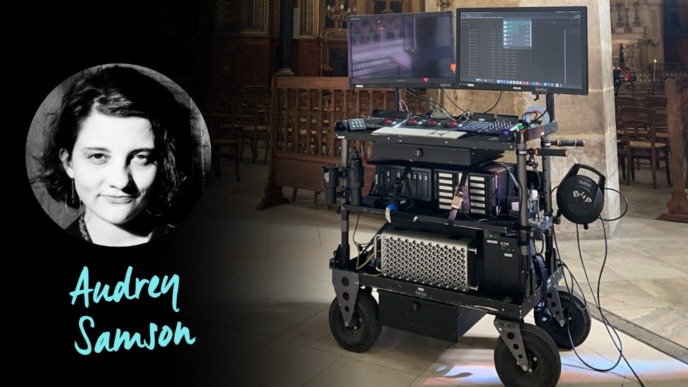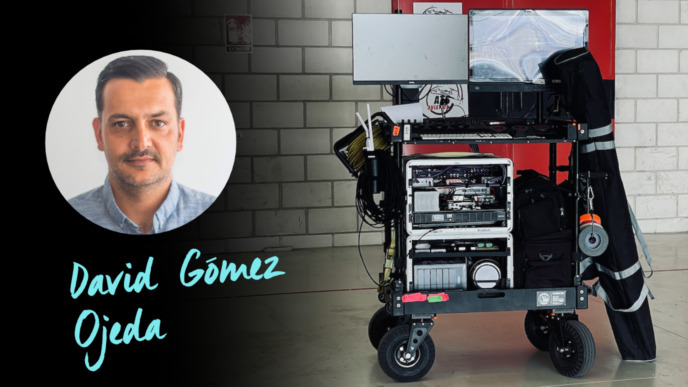
Jaime Lucero Jr.’s DIT cart attracts people to it like a moth to a flame. Whether its specialty lies within its visible features like the LED strips, or invisible features, like Jaime’s warm and welcoming vibe, this Atlanta-based commercial DIT views his cart as not only his own efficient workstation but as a professionally inviting place for everyone on set.
First of all, thank you very much for agreeing to do this interview with us! To start, could you please tell us a bit about yourself and your professional life?
My name is Jaime Lucero Jr., I’m an IATSE 600 Digital Imaging Technician and brunch enthusiast currently based in the Atlanta area since 2019. I’m originally from Vallejo, CA, and started my career in 2011 in the San Francisco Bay Area.
I was working at a community college doing camera work for an on-camera acting class. My boss’ nephew was a commercial production coordinator looking for a Production Assistant that was willing to drive a camera truck. I took the job as a PA for a few years, which then led to becoming a 2nd AC. That meant media management, and eventually led to me dedicating my life to this three-letter title we get on call sheets, where I still get asked, “what exactly do you do?”
Can you please share some details about your work?
For most of my career, I’ve worked on commercials. In SF, alongside the major brands and car commercials shooting on location, the tech industry (Apple, Meta, Google etc.) kept us all very busy. When I made the move in 2019 from SF to Atlanta, I felt like my previous experience in commercials was extremely valuable.

Nowadays, I’m still working with major brands, but I’m seeing a lot more pro athlete and hip-hop artist product endorsements. The commercials industry definitely fits me better than narrative. It’s fewer days and fewer burnouts, but you still benefit from competitive rates and the chance to work intimately with top-tier cinematographers on smaller jobs.
We’re aware that every DIT’s setup varies. Overall, how would you describe yours?
Overall, my cart could be described as light and agile- yet robust. Sounds kind of like a nice wine.

Initially, when I set up my cart I wanted it to be robust as possible, while still having a small enough footprint to fit into tight spaces. Another factor is that I drive my kit to and from set, so it must fit into the back of my Prius. I’ve gotten it down to nine pieces/cases, making it easy to keep track of things. I chose the 36″ Inovativ Voyager Evo cart as it’s lightweight and breaks down easily.
I currently roll with a pair of Flanders Scientific DM240s mounted on the Upgrade Innovations Whaley Rail II. I have a 15-inch USBC QLED monitor magnetically mounted to an articulating arm on the cart’s built-in cheese plates for my UI.
I mainly use the rack-mounted 2019 Apple Mac Pro, with maxed-out guts and 12TB of internal RAID storage. It rips through most flavors of transcodes without a hitch and still gets me wrapped out at a reasonable time. I use the BMD 12 x 12 router and Blackjet UX-1 for the random media someone ends up handing me at the end of the day. There are a few more odds and ends alongside some of the more standard DIT items like the El Gato Streamdeck and the legendary Robocups.
Which Pomfort products are you using and why?

I exclusively use Silvestack Lab and Livegrade Pro. Honestly, it’s all you need. It’s so easy to organize anything and everything. Transferring looks between the two is simple and the layouts for both are very intuitive. Creating reports has never been easier and the Stream Deck and Tangent Panel integration are a lifesaver. Silverstack Lab is an essential tool for the commercial world since there’s usually a fast post-production turnaround. The ability to offload, sync sound, and quickly transcode proxies on-set is a highly sought-after ability for commercial DITs. The technical support is also fantastic, I’m just a few clicks away from a software upgrade to support the latest codec or color pipeline.
How do you handle the power supply on set?

My power setup is built out of a 3U SKB case sitting vertically at the ends of the cart handles. A Cybe Power 1500W UPS and Meon LiFe Cart battery system supply DC power to everything except the Mac Pro via 4-pin XLR cables. So that means no more wall warts or power strips, and I can have monitors up and running for an hour or two while I’m still waiting for a lunchbox to get dropped near me.
What other accessories or special features do you have on your cart?

I try to make my cart easy and adaptable when I’m working closely with the DP. Depending on which side they prefer to stand on, from which direction they approach the cart, and whether they are left or right-handed, I shift my UI and single-channel cradles to accommodate them.
Do you have one fixed setup for your cart? Or does it vary depending on the job?

I have a pretty fixed setup, but I do have a small 2U rolling case that contains a MacBook Pro, a BoxIO, and mounts for the Odyssey 7Q and Teredeck receiver. I use the rolling case for jobs that are in the middle of nowhere. I’ve modeled it after the DITBOX, but it’s way less presentable.
Personally, what’s your favorite component of your setup and why?
My favorite component would have to be my OneRack mounting solution from TvOne. All of my smaller electronics like BoxIOs, routers, Blackmagic Design mini monitor/recorders, Decimator Quad, USB hubs, and DC hotbox are all mounted vertically on removable trays. If anything needed to be serviced, I could just pull one tray out without having to take apart the whole deal. The front is clear plexiglass which I lined with an LED strip. Not only does it always get a second glance and brownie points1, but the LED strip also serves as a work light and a way to verify power distribution.

What has been the latest addition to your setup?
A fellow DIT Sam Petrov 3D prints these DIT stop signs for my stinger. Aside from the compliments from G&E, I have yet to be unplugged by accident! Although everything has been getting smaller, so I am considering revamping my kit.
Are there any notable stories that have happened with or to your setup that you’d like to share with us?
Nothing specific, but I’ve noticed that over the years certain instances that are unique to a DIT. Since I have the biggest monitors on set that aren’t part of the video village, my cart becomes a hotspot of activity on jobs. I don’t only get visits from DPs and Directors, but also from gaffers, VFX, the glam squad, and even sneaky clients and agents will pop up next to me from time to time. I’ve learned to keep the space light-hearted and professionally inviting while on set, which I believe every DIT should incorporate into their setup.
Is there anything we haven’t covered that you would like to add?
Our jobs are so shrouded in mystery and there are not that many places for someone just starting to find out information about learning the craft. Thank you for the great product, and support and for giving us the chance to share our story!
A big ‘thank you’ to Jaime for sharing your cart with us!
1Brownie points is American slang for “recognition for a good effort”
The State-of-the-Art Digital Imaging System

Jaime Lucero Jr., DIT
Jaime Lucero Jr. is a freelance Local 600 Digital Imaging Technician.



